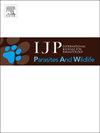根据目前对灵长类蜕螨动物群的了解,从塞内加尔丛林猴 Galago senegalensis 身上发现的新蜕螨(蛔形目:蜕螨科),并附带一份病例报告说明
IF 2.2
3区 医学
Q3 ECOLOGY
International Journal for Parasitology-Parasites and Wildlife
Pub Date : 2025-03-08
DOI:10.1016/j.ijppaw.2025.101053
引用次数: 0
摘要
灵长类动物的蠕形螨区系所知甚少,不仅对其寄主范围知之甚少,而且对不同螨种在单个寄主物种中共存的可能性也知之甚少。到目前为止,在灵长类动物中只发现了来自5个宿主物种的7个物种,包括在单孔鼻亚目3个物种中发现的5个物种,包括短蠕形螨,毛囊蠕形螨,它们与人类有关,可引起各种疾病症状。剩下的三个物种只在圈养环境中被发现过一次:恒河猴、圭亚那松鼠猴和红手绢毛猴。然而,在Strepsirrhini亚目的一个代表物种中发现了两个物种,即来自卢旺达的莫霍里丛林婴儿Galago moholi。一种新种,加拉戈斯Demodex galagoensis sp. nov,现已被描述为塞内加尔丛林幼崽加拉戈斯塞内加尔,作为宠物饲养;蠕螨引起了头部皮肤的疾病症状。研究强调了协调兽医检查与正确鉴定和分类分析的重要性;这种方法为我们对生物多样性的认识提供了新的数据,因此,正确的识别是开发有效处理方法的重要因素。本文章由计算机程序翻译,如有差异,请以英文原文为准。

Demodex galagoensis sp. nov. (Acariformes: Demodecidae) from the Senegal bushbaby Galago senegalensis in the light of the current understanding of the demodecid mite fauna of primates, with notes on a case report
The Demodecidae fauna of primates is very poorly known, not only with regard to its host range, but also the possibility of the co-occurrence of different mite species in individual host species. So far, only seven species, from five host species, have been described from primates, including five species identified in three species from the suborder Haplorrhini, including Demodex brevis, D. folliculorum, which are associated with humans, in whom they can cause various disease symptoms. The three remaining species have been found only once in captivity: in the rhesus macaque Macaca mulatta, the Guianan squirrel monkey Saimiri sciureus and the red-handed tamarin Saguinus midas. However, two species were found in one representative of the suborder Strepsirrhini, the moholi bushbaby Galago moholi from Rwanda. A new species, Demodex galagoensis sp. nov, has now been described from the Senegal bushbaby Galago senegalensis, kept as a pet; the demodecid mites caused disease symptoms in the skin of the head. Studies highlight the importance of coordinating veterinary examinations with correct identification and taxonomic analyses; such an approach contributes new data to our understanding of biodiversity, and consequently, correct identification is an important factor in the development of effective treatment methods.
求助全文
通过发布文献求助,成功后即可免费获取论文全文。
去求助
来源期刊

International Journal for Parasitology-Parasites and Wildlife
Medicine-Infectious Diseases
CiteScore
3.80
自引率
5.60%
发文量
113
审稿时长
45 days
期刊介绍:
The International Journal for Parasitology: Parasites and Wildlife (IJP-PAW) publishes the results of original research on parasites of all wildlife, invertebrate and vertebrate. This includes free-ranging, wild populations, as well as captive wildlife, semi-domesticated species (e.g. reindeer) and farmed populations of recently domesticated or wild-captured species (e.g. cultured fishes). Articles on all aspects of wildlife parasitology are welcomed including taxonomy, biodiversity and distribution, ecology and epidemiology, population biology and host-parasite relationships. The impact of parasites on the health and conservation of wildlife is seen as an important area covered by the journal especially the potential role of environmental factors, for example climate. Also important to the journal is ''one health'' and the nature of interactions between wildlife, people and domestic animals, including disease emergence and zoonoses.
 求助内容:
求助内容: 应助结果提醒方式:
应助结果提醒方式:


